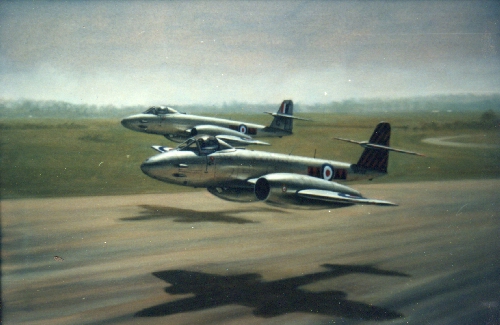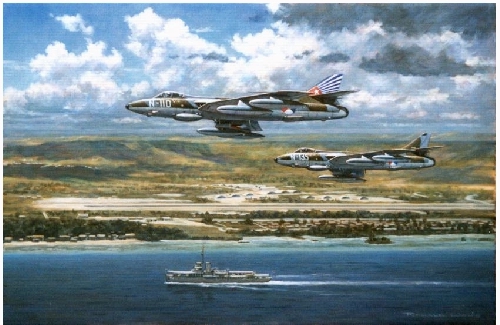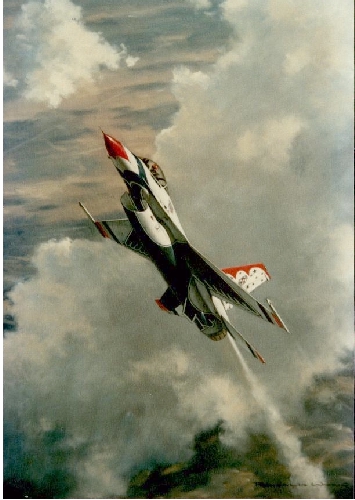|
|
|
The article below ( QN Summer 2008) was written in answer to, and with the purpose of providing balance against, a preceding article in our Guild newletter which I feel overstates the virtues of painting museum pieces, even when the title was "Painting En Plein Air". Ron --------------------------------------------
The Art of Flight: Flying Machines Flying!With the recent attention on painting aircraft as essentially static forms, someone has to put in a word for the painting of FLIGHT. A memorable childhood birthday present was a book on the RAF illustrated with some paintings by Frank Wooton. It was those deep, inspirational skyscapes which uplifted my imagination in my formative years and made an indelible impression. Where now are the vistas which instantly transport the mind's eye to thousands of feet, to distant horizons, "loosening the bonds of Earth"? Those sunlit panoramic settings in which our magnificent flying machines breathe and find their meaning? Think of the presence of those Wooton and Coulson skyscapes. Or for that matter some of those popular Taylors and Trudgians. The powerful aerial vistas which sustain their aircraft are unmistakable elements in the realism, authority and appeal of their work. When they do occur in our midst....and good examples are some of the recent work by Alex Hamilton and Tony Cowland....they truly stand out.
Spitfire Joy We are very fortunate in our choice of subject. Earthbound art naturally strains to escape from the familiar and obvious, to attain to new and greater vistas. Aviation art by its nature offers these freedoms on a plate, would that we artists embrace them! For us, there is little cause to revert to the familiar and jaded stylistic fixes in a pretence of seeking artistic "novelty". That extra vertical dimension vastly expands and enriches the other two. What we have is a truly novel and liberating perspective which supercedes the largely Flat Earth views of our everyday lives and opens up a whole new world of experience. Painting the infinitely variable moods of the skies should be second nature for us, as it is for marine artists to paint the seas. Yet what too often emerges in our images are shallow and grudging backdrops which contribute little to the feeling of height and flight.
Mercy Mission to Angola Why should this be? A strong clue was provided by my own experience as a teaching "faculty" member of the American Society of Aviation Artists(ASAA). Students who display consummate skill at detailed depiction of grounded aircraft nevertheless struggle to get their imagination off the ground to put together a sensible aerial perspective. It became clear that the difficulty was in SEEING depth and space in their mind's eye. And if you cannot see it there you cannot transfer it to the canvas. This brings to mind an anecdote about Congolese pygmies, who habitually live in dense jungle and had no need to handle far perspectives. When led out on to open savannah, they reacted with shock and disbelief when told that what they took to be a nearby line of beetles was in reality a herd of buffalo in the distance!
Meteor Scramble Now, we can all appreciate the romance and enjoyment of painting close up with the subject in traditional fashion. I can well recall the conglomerates of glass, wood, cutlery, cloth and fruit allotted to us at evening art classes. Hardly exciting material in themselves but an ideal introduction to differing shapes, colours, textures and light effects. There was little scope for compositional worries, and the closed reflex loop provided for a pleasurable and relaxed flow between the subject, the eye and the brush in a convivial atmosphere. Likewise for aviation artists, painting empirically from unmoving machines offers unrivalled opportunities to acquaint ourselves with the complex structural detail of diverse aircraft types*. No surprises there. And no surprise that the congested interiors of museum hangars with their captive, static forms should usually yield vignetted studies where the wider spatial context is incidental if not irrelevant. Even the outdoor static displays are often depicted like architectural shapes, with little hint of the inherent dynamism of the designs. Not unlike practicing with stuffed and reconstructed museum pieces in the name of painting wildlife, even when these are neither wild nor live. This is aviation depicted as Still Life, and while it certainly has its educational place, we have to remember it is just one end of a wide spectrum. And there definitely is a cognitive hurdle from there to the depiction of flight itself which we need to recognize. I recently approached some busy Guild members painting away inside the Cosford Museum, and gently inquired about painting flight itself. One response was a pause, a deep frown, and the exclamation: "I'd have to THINK....!!"
Kai Tak: Final Approach There indeed needs to be that leap of thought and creativity to bridge that gulf.....and usually a quantum jump in scale of the artwork, from inches to feet, which corresponds to an expansion of vision beyond the charming little still life vignettes. This is the obverse of the old chestnut about painters being too tightly aircraft-focused. What is required is to visualize flight as a whole, to paint our aircraft in their natural element as a totality. At the mental level, it is a shift of focus away from dependency on the immediate object to one of independent and internalised creation. Yes, often in the privacy of our studios and drawing on whatever experience and knowledge of the subject we have garnered, and whatever references are to hand, in order to flesh out that central act of creative imagination and give it life.
Storm Clouds Over New Guinea, 1962 The miracle of flight is an ancient dream of mankind. From the legends of Icarus and others, Man has looked to the skies and envied the freedom of the birds.....and of imagined gods. Only very recently has this freedom been realized. Those who experience raw flight outside of the cozy pressurized fuselages tend to appreciate this more. I had my own moments in gliders and some large-canopied fast jets, but what stands out is my time on a 1911 Wright Flier in Ohio in 2003. The only thing to beat that has to be those recent Swiss jet wings. Aviation art reflects this new-found freedom, and offers the greatest perspective of all, potentially embracing everything within the earthly atmosphere... land, sea, air, and perhaps a little beyond**. Little wonder that aviation painters often find little difficulty side-stepping into marine or motoring or landscape art, and even human and animal subjects, or incorporating these into their aviation work. On the other hand it is an annual struggle to decide the subject matter to paint for that Guild Exhibition. The unique breadth and depth of our subject should challenge us to open our vision ever farther afield. And to keep our imaginations and that learning curve moving upwards.
Thunderbird One Ronald Wong GAvA May 2008 *However, it will not do to dismiss the interacting textures, shadows and reflections on aircraft bodies as merely disconnected "abstract" phenomena to be playfully splashed about on the canvas, because they are NOT. These are real and predictable physical effects which aviation artists need to study and understand in order to advance their art. ** Anyone for a Guild of Aerospace Artists? |





